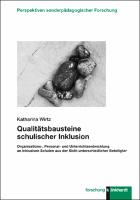Qualitätsbausteine schulischer Inklusion
Organisations-, Personal- und Unterrichtsentwicklung an inklusiven Schulen aus der Sicht unterschiedlicher Beteiligter
Abstract
"As a result of the UN-Convention on the Rights of Persons with Disabilities schools are faced with the challenge to develop inclusive education for pupils with and without special educational needs. This doctoral thesis puts its focus on the question, which elements of quality play an important role concerning the reorganization of the educational system in Germany into an inclusive one. To be able to embed these elements including organizational change, personnel development and the development of teaching in a theoretical framework the second chapter first of all describes historical aspects of inclusive schooling in Germany during the last decades as well as different viewpoints of scientific theories. It seems obvious that reform processes can be compared to wave movements, which end up in restorative efforts after an initial swing of reforms. In addition, demands for inclusive education from the 70s are surprisingly unchanged in the
current discourse. Different scientific theories (sociology, educational sociology, theories of education and special education) shape this discourse by a various understanding and use of terms like exclusion and inclusion. The analysis of this scientific discussion leads to the conclusion that attending a so-called „inclusive school“ is not to be equated with the social inclusion of children and young people in general. In the third chapter empirical research concerning the quality of inclusive education from two scientific viewpoints is brought together: the view of special pedagogy and the view of research on schools and teaching in general. Categories, sub-categories and indicators of this quality in the fields of organization, personnel and teaching of (inclusive) schools are collected, systematically structured and weighted by a qualitative and quantitative content analysis of the previous research literature. This approach results in a system of categories that gives an overview about this complex research field and provides a basis for further research.
The results of two surveys, which have been carried out in the federal state of Saarland, are described and interpreted in the fourth chapter. In this state inclusive education has been practiced for more than thirty years. The qualitative sub-study includes 25 interviews, the quantitative sub-study involves 32 primary and secondary schools as well as four support- and advice centres for inclusive education. Both surveys analyse the perception und evaluation of the quality of inclusion from multiple perspectives: the views of headmasters, mainstream and special school teachers, parents of children with special educational needs and the viewpoints of the pupils themselves. Describing the connections between those different perspectives gives a deep insight into the inner life of inclusive schools.
Conclusions for the development of individual schools as well as for the education system as a whole are derived from the results of the studies. Moreover those conclusions are critically classified against the background of the theoretical framework that has been described in the second chapter." "Im Zusammenhang mit der UN-Behindertenrechtskonvention stehen Schulen vor der Herausforderung
Schülerinnen und Schüler mit und ohne sonderpädagogischen Förderbedarf
gemeinsam zu beschulen und zu unterrichten. Die vorliegende Arbeit analysiert, welche qualitativen
Bausteine bei der damit verbundenen Umgestaltung des Bildungssystems eine Rolle
spielen und welche Bedeutung die einzelnen Bausteine für die (Weiter-) Entwicklung inklusiver
Bildungsangebote haben können.
Damit die Qualitätsbausteine in den Bereichen Organisations-, Personal- und Unterrichtsentwicklung
von Schulen in einen theoretischen Gesamtrahmen eingebettet werden können, werden
im zweiten Kapitel zunächst geschichtliche Eckpunkte der Umsetzung schulischer Integration in
den letzten Jahrzehnten erfasst. Es zeigt sich, dass Reformprozesse Wellenbewegungen vergleichbar
sind, die nach einem ersten Reformschwung häufig in restaurativen Bemühungen enden. Darüber
hinaus stehen Forderungen zur Gestaltung integrativen Unterrichts aus den 70er-Jahren
erstaunlich unverändert auf der Agenda des aktuellen Inklusionsdiskurses. Dieser Diskurs wird
in unterschiedlichen Fachwissenschaften (Soziologie, Bildungssoziologie, Allgemeine Pädagogik,
Sonderpädagogik) wiederum durch eine Vielfalt von Begriffen und Sichtweisen geprägt, deren
Analyse die Schlussfolgerung nahelegt, dass eine „inklusive Schule“ nicht gleichzusetzen ist mit
der umfassenden gesellschaftlichen Inklusion von Kindern und Jugendlichen.
Im dritten Kapitel werden bisherige Forschungsergebnisse zur Qualität schulischer Integration
aus der sonderpädagogischen Integrations- bzw. Inklusionsforschung sowie der allgemeinpädagogischen
Schul(entwicklungs)- und Unterrichtsforschung zusammengeführt. Qualitätskategorien,
-subkategorien und -indikatoren aus den Bereichen Organisations-, Personal- und
Unterrichtsentwicklung von (integrativ arbeitenden) Schulen werden mit Hilfe einer qualitativen
und quantitativen Inhaltsanalyse der bislang vorliegenden Forschungsliteratur in einem
Kategoriensystem gesammelt, systematisierend strukturiert und gewichtet, wodurch sowohl
ein Gesamtüberblick zu dieser komplexen Thematik entsteht als auch eine wissenschaftliche
Grundlage für die Forschungsvorhaben geschaffen wird.
Im empirischen Teil werden die Ergebnisse von zwei Erhebungen dargestellt und interpretiert,
die im Saarland durchgeführt worden sind - einem Bundesland, das über jahrzehntelange Erfahrung
mit der schulischen Integration von Kindern und Jugendlichen mit sonderpädagogischem
Förderbedarf verfügt. Die qualitative Teilstudie umfasst 25 Interviews, die quantitative Teilstudie
bezieht 32 Grund- und Gemeinschaftsschulen sowie vier Förder- und Beratungszentren
ein. Beide Erhebungen sind mehrperspektivisch angelegt und analysieren die Wahrnehmung
und Einschätzung der Qualität schulischer Integration aus der Sicht von Schulleitungen von
Förder- und Beratungszentren sowie Grund- und weiterführenden Schulen, Regel- und Förderschullehrkräften,
Eltern von Kindern und Jugendlichen mit sonderpädagogischem Förderbedarf
sowie den Schülerinnen und Schülern selbst. Die Verknüpfung dieser unterschiedlichen
Perspektiven ermöglicht einen umfassenden Einblick in das Innenleben inklusiver Schulen.
Aus den Ergebnissen der Studien werden sowohl Schlussfolgerungen für die Entwicklung von
Einzelschulen als auch für das Bildungssystem insgesamt abgeleitet. Im Fazit werden diese
Schlussfolgerungen vor dem Hintergrund des im zweiten Kapitel erarbeiteten theoretischen
Rahmens zudem kritisch eingeordnet."
Keywords
Inclusion, School, Integrative education, Inclusive education, Inclusive school, Quality, Organizational development, Personnel development, Learning and teaching development, Teaching improvement, Remedial instruction sciences, Special education for the handicapped, Special needs education, Special Educational Needs, Teaching quality, Pupil, Pupils, Headteacher, Headteachers, School head teacher, Parents, Teacher, Perception, Pupil integration, Empirical research, Qualitative research, Quantitative research, Germany, Inklusion, Schule, Integrative Pädagogik, Integrative Schule, Qualität, Organisationsentwicklung, Personalentwicklung, Unterrichtsentwicklung, Sonderpädagogik, Sonderpädagogischer Förderbedarf, Unterrichtsqualität, Schüler, Schulleiter, Eltern, Lehrer, Wahrnehmung, Schulische Integration, Integrationsforschung, Interview, Empirische Forschung, Qualitative Forschung, Quantitative Forschung, Saarland, Deutschland,DOI
10.35468/5848ISBN
9783781524156, 9783781558489Publisher
Verlag Julius KlinkhardtPublication date and place
Bad Heilbrunn, 2020Series
Perspektiven sonderpädagogischer Forschung,Classification
Educational strategies and policy: inclusion


 Download
Download Web Shop
Web Shop